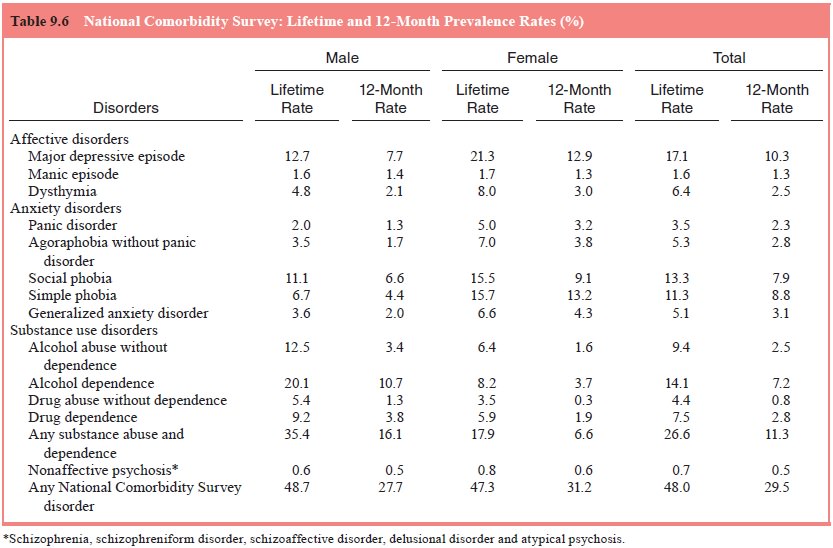Chapter: Essentials of Psychiatry: Psychiatric Epidemiology
The National Comorbidity Survey
The National Comorbidity Survey
Because the ECA study was conducted in five specific sites, each selected because it contained unique population characteristics. the findings could not be readily extrapolated to the USA as a whole. Therefore, the NCS was designed to estimate the prevalence and comorbidity of psychiatric and substance use dis-orders in the mainland USA. The NCS was designed by Kessler and colleagues (1994) as the first population-based study admin-istered to a nationally representative sample in the USA using astructured diagnostic interview. It built upon a history of con-ducting (second-generation) national studies of the prevalence of psychiatric symptoms in the USA at the University of Michigan. The NCS also built on the knowledge and experience of the ECA study. Among its many advantages, it uniformly included a set of demographic and psychosocial risk factors.
Prevalence
Table 9.6 presents the NCS 1-year and lifetime
prevalence rates of the various psychiatric disorders. Lifetime prevalence
rates are the proportion of individuals who ever experienced a disorder, and
1-year prevalence represents the proportion of individuals who experienced a
disorder in the year before the interview. The lifetime prevalence for any
DSM-III-R disorder was 48.7%, and the 12-month prevalence was 27.7%. When
grouped by diagnos-tic category, the lifetime prevalence rates were 24.9% for
anxiety disorders, 26.6% for substance abuse and dependence, and 19.3% for
affective disorders. As expected, anxiety and affective dis-orders were more
common in women, and substance abuse was more common in men.

Comorbidity
An important focus of the NCS was the assessment of
comorbid-ity. Interestingly, whereas 21% of the sample experienced only one
disorder, 14% met criteria for three or more lifetime disor-ders. Furthermore,
among individuals with a lifetime disorder, 53.9% had three or more lifetime
disorders. Among individuals with a disorder occurring in the past 12 months,
58.9% expe-rienced three or more disorders. The level of comorbidity was most
dramatic for individuals with a severe disorder in the past 12 months, defined
as active mania, nonaffective psychosis, or active disorder of other types that
either resulted in hospitaliza-tion or created severe role impairment. In that
subset of respond-ents, 89.5% had three or more disorders.
Risk Factors and Correlates
The NCS also yielded important data on demographic
correlates and potential risk factors for mental disorders. Several earlier
patterns of association observed for gender and other character-istics were
confirmed.
Use of Mental Health Services
The NCS also examined the patterns of use of health
services by the respondents. Only 40% of individuals with a mental dis-order
ever received professional care, and only 25% received their care in the mental
health specialty sector. On the other hand, 60% of individuals with three or
more comorbid dis-orders received professional help, 40% in the mental health
specialty sector. Furthermore, one third of persons with three or more comorbid
disorders received professional help in the past year compared with only 20% of
those with one disorder. These findings indicate that the use of health
services is con-centrated in the segment of the population with a high degree
of comorbidity.
Subsequent analyses of service utilization in the
NCS have shed light on the magnitude and potential determinants of impor-tant
subcomponents of the problem of unmet needs for mental health treatment. For
example, while only a minority with ac-tive major depression received any care
in the prior year, an even smaller percentage (7%) received treatment that
could be consid-ered minimally adequate (Katz et al., 1998). Even among the ex-tremely vulnerable and impaired
population that met criteria for active serious mental illness (SMI), only 40%
received any treat-ment in the prior year (Kessler et al., 2001) and only 15% received care that could be considered
minimally adequate (Wang et al.,
2002). Among NCS respondents with mental disorders who re-ceived treatment in
the prior year, 19% dropped out prematurely (Edlund et al., 2002).
The Ongoing NCS Research Program
The NCS will continue to yield important new
findings in the future, though a new series of landmark studies are currently
in the field (Kessler and Walters, 2002). In one ongoing component of this
research, the National Comorbidity Survey-2 (NCS-2), the baseline NCS
respondents were reinterviewed a decade later. When linked with the
prospectively-collected data that respond-ents had provided in the baseline NCS,
the NCS-2 will be an important source of information on the patterns and
predictors of the course of mental disorders. The NCS-2 will also provide
investigators with the ability to study the effects of primary dis-orders on
the development and course of secondary disorders. An additional survey with a
new national sample of 10 000 respond-ents, the national comorbidity
survey-replication (NCS-R), is also being conducted together with the NCS-2.
The NCS-R data will provide much needed data on temporal changes that may have
occurred in the past decade. The tremendous utility of such analy-ses is
perhaps best illustrated in mental health services research, where the last
decade has seen dramatic changes in treatments and service delivery systems,
yet the impact of these changes on unmet needs for treatment remains largely
unknown. A survey is also being conducted among 10 000 adolescents, the NCS-A,
and will yield much needed information on the occurrence and correlates of
mental disorders in this population. Finally, as part of the WHO WMH (Womens
Health and Gender) 2000 initia-tive, the NCS-R is being administered as
parallel community epidemiological survey in over 20 developing as well
developed countries throughout the world. The cross-national comparisons made
possible by these surveys will provide a unique look at the occurrence, burdens
and patterns of treatment for mental disor-ders around the globe.
Related Topics